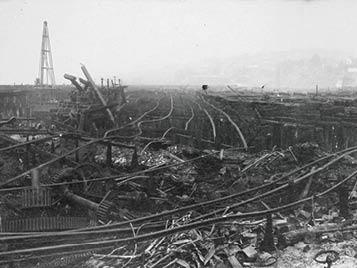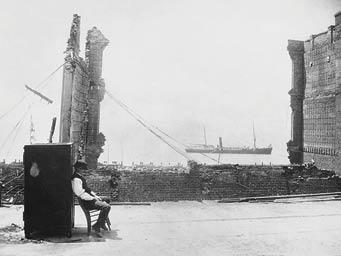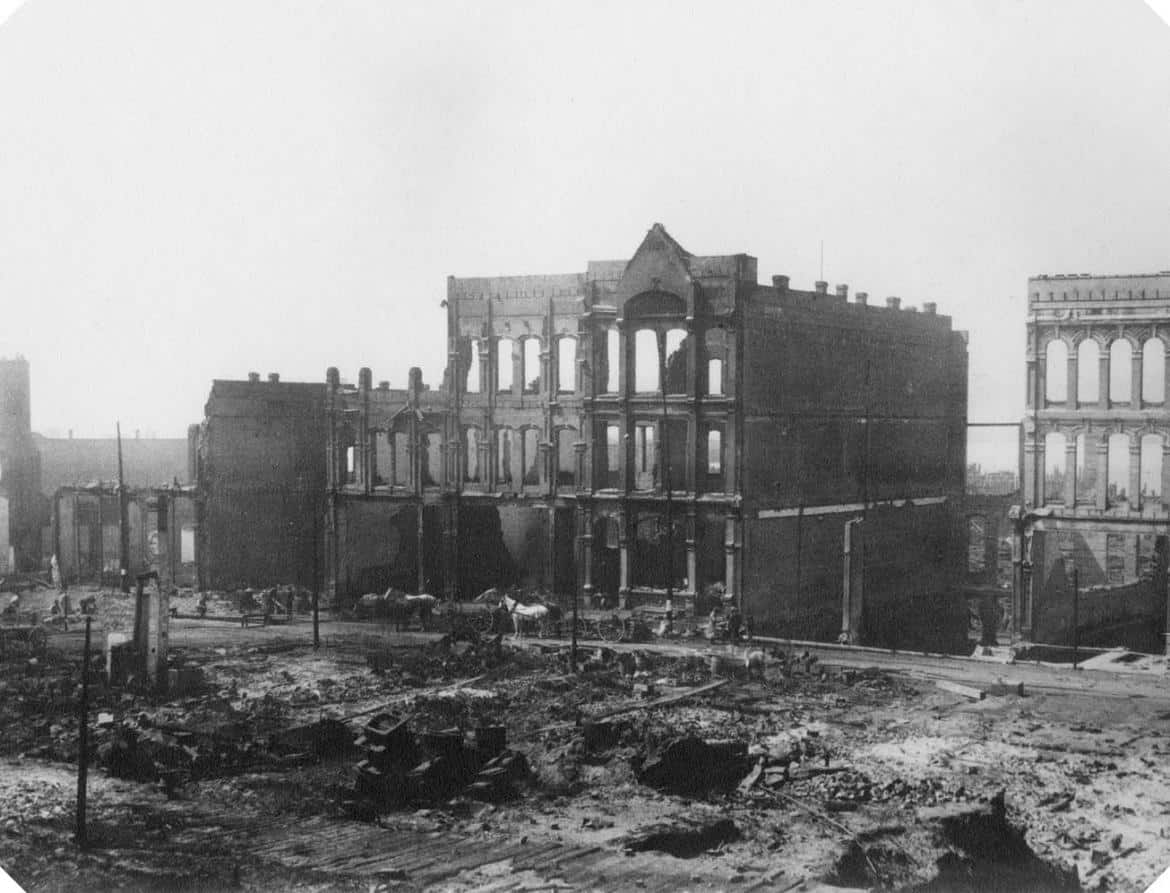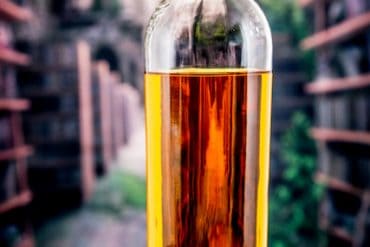How Seattle grew into itself, thanks to the devastating Great Seattle Fire
written by Sheila G. Miller
Whether it’s because of Frasier reruns, Pearl Jam’s popularity, Amazon or Starbucks, everyone knows Seattle. The largest city in the state of Washington and in the Pacific Northwest is known for its coffee, its rain, its music.
But in 1889, the same year Washington became a state, Seattle burned—in what is called the Great Seattle Fire—and that paved the way for Seattle to go from a boom-and-bust timber town to the tech-savvy Space Needle-centered spot we see today.
Tom Walsh, a deputy chief for the Seattle Fire Department, said these types of fires were not uncommon.
“Chicago, Spokane, Boston, New Orleans all had great fires due to the prevalence of construction that enabled quick fire spread, proximity of buildings, lack of adequate water supply and volunteer rather than professional fire departments,” he said.
On June 6, 1889, it was Seattle’s turn.



ACCORDING TO THE UNIVERSITY OF WASHINGTON’S digital archives, spring in 1889 was sunny and warm, in the 70s with little rain.
The basic, and in some cases incorrect, story goes like this—a woodworking assistant in a shop on Front Street (today, First Avenue) and Madison Avenue was heating glue over a fire. The glue boiled over around 2:15 p.m., catching fire and spreading to the floor, which was covered in turpentine and wood chips. In an attempt to put out the blaze, the assistant doused it in water, but this spread out the turpentine and the fire. The fire department arrived around 2:45 p.m., but with so much smoke it was hard to find the fire’s source, and it spread out of control. The fire department struggled to fight the blaze because water pressure fell, and hoses couldn’t reach the water in Elliott Bay because of low tide.
Page Olson, the president of the Last Resort Fire Department, has spent much of her time researching the Great Seattle Fire. The Last Resort Fire Department is a historical nonprofit dedicated to preserving Seattle’s fire department history through the acquisition of fire trucks and engines. The group has a museum that honors that history—and Olson became the de facto expert on the early history of the city’s firefighting, up until the department no longer used horses.
Olson said there remains a lot of misunderstanding about the fire—how it started, how it grew, and why it ended. She blames the errors on a lack of understanding of Seattle’s topography at the time, as well as people bringing their current understanding of fire—how it burns in modern buildings—to the story.
“If you take what you know today and what Seattle looks like today and make that the baseline, you’re never going to get it right,” she said.
For starters, Seattle in the 1880s looked a lot different. Around Madison Street, everything west of where First Avenue stands today was underwater. There were bluffs about the height of a one-story building above tidal flats, and then the land rose sharply from there as you headed east, deeper into the city.
It was at First and Madison that the fire started, in the basement of a building that was separated from the next by just a wooden wall.
“This business where the fire began is below grade, which is critically important as the streets at that time were wooden planked streets,” Olson said.
Among Olson’s quibbles with the long-held versions of the fire’s origins? The glue pot.
Five people were working in the cabinetry shop that day, Olson said. “That’s why you get so much erroneous information. Just like any other accident, multiple people all give you a different version of what happened. They’re all looking in different directions or focusing on something different, so they see different things.”
If you take what you know today and what Seattle looks like today and make that the baseline, you’re never going to get it right. —Page Olson, The Last Resort Fire Department.
But, Olson said, the original interviews with the employees all agree. John Back cut some glue with scissors and placed it in a glue pot on the top of the wood-burning stove. The stove, Olson said, had a divot specifically designed for the pot. Back threw turpentine-laced shavings into the stove. But the stove got too hot, and, Olson said, the glue spontaneously combusted after passing its ignition point. Fire shot out of the glue pot. Another employee slid a wooden board across the top of the pot to suffocate the fire, Olson said, but it was impossible to seal the top and shut out the oxygen because of two small apertures for the pot’s handle. Soon the board was on fire, too. Someone threw a bucket of cold water on the fire. “If it had been warm water, the room wouldn’t have exploded,” Olson said.
The glue exploded and bits of it spewed across the shop, spreading smoke and fire everywhere.
Two steamers, pulled by horses, responded to the fire, Olson said. One went to the dock at Columbia Street to draft water from the bay, but because the tide was so low, it took thirty minutes to get water into the hoses—though they did eventually access that water. It took other firefighters on site thirty minutes to figure out where the fire was coming from. “They saw smoke but they didn’t see flames,” Olson said. Firefighters pulled up the sidewalk, and that’s when they found the inferno.
“Because the fire was below grade, it was able to get in underneath the streets,” Olson said.
The bad luck didn’t end there. The water used in the area where the fire started came from natural springs on what is today called First Hill (and also, commonly, Pill Hill). Olson said the city had six gulleys that went down the hillside and emptied water into Elliott Bay, with sidewalks and plank streets above. Hollow trees served as the sewage and water system, attached to the underside of the streets. Water was privately owned, and the Spring Hill Water Co. served the downtown commercial area, with a pumphouse on Lake Washington that sent water up to a 5-million gallon reservoir at the top of Beacon Hill. Fire hydrants were still scarce, Olson said—they’d begun appearing only in 1887. But the water pressure for the area was traditionally pretty good.
As firefighters pulled the spring water from the hydrant, pressure dropped.
“It was an instantaneous cataclysmic failure,” Olson said. “Because it was below grade, the fire was able to get underneath the street and damaged supports for the water system and the water system failed.” An interview in the 1960s with the man working at the pumphouse that day told the deeper story—with the damaged structure, the water was being pumped right into Elliott Bay instead of into the hydrants.
That’s when the mayor, who had taken over command from acting chief James Murphy (the real chief, Josiah Collins, was out of town for a convention), divided people into three groups—one to serve as a bucket brigade, one to remove valuables from the buildings nearby, and one deputized to protect the items removed and placed in other parts of town.
WALSH SAID A VARIETY of factors, including the wood-framed buildings in close proximity, the lack of fire hydrants, the warm weather and the all-volunteer fire department, added up to disaster.
“Once a fire gets to a certain size, it begins pre-heating other buildings, and large embers are carried aloft and the fire can spread across streets,” he said. “Firefighters actually attempted to dynamite buildings to create a fire line, to no avail. We don’t do that anymore.”
It’s hard to imagine, today, why it took so long for the fire to burn through the city’s buildings. The answer, Olson said, is the difference in the lumber used in the 1880s versus today. “They had these huge dimensional timbers,” she said.
By late afternoon, smoke could be seen in Tacoma, and reinforcements were called in from as far as Portland and Victoria, BC.
People moved their possessions up into residential neighborhoods in the hills or put them onto ships that headed to the middle of Elliott Bay.
Murray Morgan’s seminal work on Seattle, called Skid Road: An Informal Portrait of Seattle, described people trying to save the spoils of the Opera House. “Inside the building stagehands worked desperately to haul scenery to safety,” he wrote. “A rescue party climbed to the Masonic Hall on the third floor and came out with the more important effects, but the building was lost.”
Later, the fire reached Trinity Church, which Morgan wrote, few were eager to save. “‘It was a wooden structure and had on its front end a tall belltower,’ one volunteer fireman said later. ‘It was so ugly the fire would have been a failure if that tower had been left standing.’”
A judge kept a murder trial in session as the fire blazed around the courthouse until it was only 100 feet away, then asked jurors to help save the courthouse and its records. As 120 prisoners were removed from the courthouse, a young man went to the roof and poured buckets of water on the roof to stop it from burning.
With wind blowing from the northwest, the fire headed to the southeast. Ultimately, Olson said, the south end of the fire burned out when it hit the tidal flats. The area toward the south end of the fire was almost entirely wooden docks—in fact, one of the mills that burned saved its saw blades by cutting a hole in the floor and dumping them in the water before the fire arrived.
Firefighters were able to stop the fire to the north, but it was a long, slow fight. In one area, the fire was slowed because of a hole in the ground, while in another area the bucket brigade covered glass windows with wet blankets, preventing the windows from breaking and the fire from getting inside the buildings. Along the eastern edge of the fire, shorter buildings with less fuel allowed firefighters to get ahold of the flames.



THE FIRE BURNED until 3 a.m. Twenty-five city blocks, a total of 120 acres, were destroyed. The wharves between Union and Jackson streets were gone. No humans died in the fire, though as many as 1 million rats did. UW notes that about 5,000 men lost jobs, and the city estimated its losses to be $8 million, when it may have been as high as $20 million. The cost of the fire, in today’s dollars, is about $697 million. All told, one person died as a result of the fire—but not until June 27, when a wobbly brick wall fell into a pit, killing one man and injuring another.
“Seattle, prior to this fire, was a pioneer town,” Olson said. “It was a backwards cesspool. It was like a glorified logging camp, though there were families and children. But it was a really nasty place and it stunk.
“Before the fire, the city was trying to figure out how to fix that. It wanted to become a legitimate city. And to be able to do that they knew they had to raze the Pioneer Square area, and deal with the sewer problem and the rats and stuff.”
The fire allowed Seattle to transition from a timber and coal town into a seaport. There was no time to waste. At 11 a.m. the next morning, citizens held a meeting to determine how best to move forward. The decision? Rebuild.
It didn’t hurt, Olson said, that most people’s businesses hadn’t faced great losses beyond the buildings—their possessions were safe up in the hills or out on the boats, and their money was sitting in safes that hadn’t burned.
Within forty-eight hours, tents were up and people were back in business. By Sunday, businesses were announcing in the newspapers where they’d set up, and within the month more than a hundred businesses were back to work. Most rebuilt where their buildings had burned. The town was placed under martial law and a relief committee was created to deal with all the donations the city received.
Relief arrived quickly, and Walsh said that was largely due to the fact that these fires were not uncommon. Rebuilding happened so quickly that in some cases the new buildings went up on top of rubble. “Prior to the fire of 1889, Seattle’s business district was a random pastiche of wooded structures. The lack of planned design had created a city with streets too narrow to support growth, a sewer system that was hostage to the tide levels of Elliott Bay, and a resident population of 1 million rats,” Walsh said. “Without the fire, it is unlikely there would have been a complete demolition and redesign of the entire business district. The fire happily eliminated the rodent problem as well. Gold was discovered in Alaska in the Klondike, and Seattle was a natural jumping-off point for people headed there.”
Though three major mills had burned, many others had not, and they provided huge timbers to rebuild, though this time the wood would be used only for the skeletons of the buildings—brick and mortar were the orders of the day.
“People needed jobs, their places of work had burned down, so they started right away,” Olson said. “There were more carpenters than were needed. … It was like a new gold rush for the carpentry and masonry workers who flooded the area.”
And new building and fire codes prevented a recurrence of massive fire. The city required masonry walls be at least a foot thick, for example. If you look at buildings still standing today that were built in 1890, Olson said, you’ll notice each story has different shaped windows, because they believed that would prevent fire from spreading.
Within thirty days, eighty-eight brick buildings were underway or projected to be built. “There are pictures showing people repairing docks within days, as soon as it was cool enough,” Olson noted. The burned docks were left in place and built around, and coal bunkers were rebuilt within a few months. By 1890, 465 buildings had been built. Wooden buildings were banned in the area that had burned, and in some places streets were raised up to 22 feet.
After the fire, the city moved from an all-volunteer fire department to a professional one. The city took control of the water supply, eliminated wooden pipes and made the rest of the pipes larger, and increased the number of hydrants.
“It takes many men to make a masonry town,” Morgan wrote. “Seattle gained more than it lost by the fire. When the fire started Seattle’s population was estimated at 31,000. When the census takers counted the population in 1890, less than a year after the fire, they found that Seattle had 37,000 inhabitants.”








Dude, I know what this is REALLY covering up, ALL, and I mean ALL of the things you stated have no proof. Well, besides the fact that there was a lot of smoke, and a lot of names to cover up the TRUTH…..Thank god this generation is far more intelligent to research and not believe the bullshit written down by children too lazy to put any effort in their pathetic attempt to cover up the true history of WHAT ACTUALLY happened in Seattle that day. I actually laugh at whoever or whatever wrote this, next time, put a little imagination in your fake story. Put a litttle effort into your research, or I should say NO research. Where are your references of proof? What Journalist wrote this article? The Seattle fire itself, since thats what it states. Do you remember the fire? I do. Thanks for the moby dick story tho……boring and Inaccurate.
No one born in the 1880’s are alive today; unless if you remember your Grandparents talking about the fire.